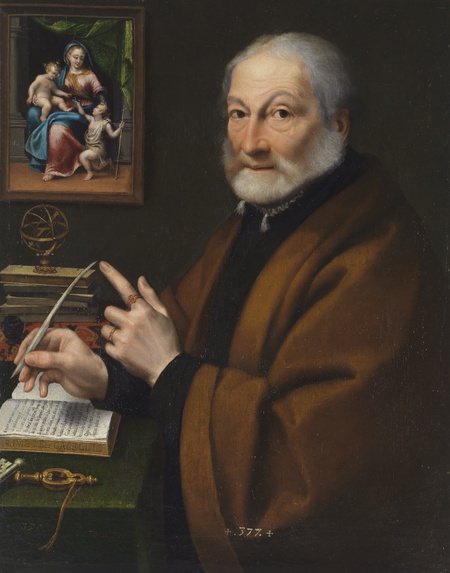Poetic Portraits: Allegory and Identity in Sixteenth-Century Europe
Featuring Sofonisba Anguissola’s Masterwork from the Museo Nacional del Prado, Madrid
November 5, 2025 – March 29, 2026
SAN DIEGO, CA— The Timken Museum of Art unveils Poetic Portraits: Allegory and Identity in Sixteenth-Century Europe, a landmark exhibition exploring the rich interplay of art, literature, and identity during the Renaissance. On view from November 3, 2025, through March 29, 2026, this exhibition brings together more than a dozen exceptional images that trace the impact of sixteenth-century art on ideas about portraiture. At the heart of Poetic Portraits is a masterwork by Sofonisba Anguissola, one of the most celebrated women artists of the Renaissance. Her Portrait of Giovanni Battista Caselli, on loan from the Museo Nacional del Prado in Madrid, anchors the exhibition and is shown in the United States for the first time at the Timken. The portrait is a commanding image of the Italian poet and scholar, distinguished by Anguissola’s remarkable attention to psychological depth and expressive realism.
“We are honored to present this extraordinary work in San Diego,” said Megan Pogue, the Timken’s Executive Director. “Poetic Portraits continues the Museum’s commitment to connecting audiences with works that transcend time and place. This exhibition offers visitors a unique lens into humanist perspectives of the Renaissance—where art and intellect, poetry and portraiture, merged to express new ideas about identity.”
A Renaissance of Ideas and Expression
During the sixteenth century, portraiture evolved beyond mere likeness. Artists, poets, and patrons alike sought to convey the virtues, intellect, and ambitions of their subjects through a sophisticated visual language of symbols, allegories, and gestures. The exhibition reveals how these layered meanings reflected the ideals of the Renaissance and the expanding role of art in European society.
Accompanying Anguissola’s portrait are select loans from important collections, including rare works from the University of San Diego’s remarkable print collection, as well as key paintings from the Timken’s own stellar holdings of Renaissance art. Seen together, these works illuminate how painters and printmakers intertwined realism with allegory to capture not only the external features of their subjects but also their social standing, moral character, and intellectual pursuits.
As Derrick R. Cartwright, Ph.D., Director of Curatorial Affairs, explained: “Renaissance portraits were never ‘just faces’. They were complex statements about identity and ambition, representations of affiliation, and status. Artists like Sofonisba Anguissola and Giovanni Antonio Boltraffio used symbols, gestures, and even costumes to transform their sitters into embodiments of virtue, intellect, or poetic talent. By revisiting these works, we gain insights into how art served as both mirror and metaphor for the Renaissance mind.”
An exemplary case in the exhibition is Boltraffio’s Portrait of a Youth Holding an Arrow, painted around 1500. The inclusion of an arrow and a wreath of laurel leaves link the sitter to the allegory of poetry—an artistic choice that transforms the portrait into a meditation on creative inspiration. Renaissance audiences understood such symbolism instinctively, reading these works much like the verses and sonnets they admired.
The Rediscovery of Sofonisba’s Gentleman
The Timken’s presentation celebrates not only Anguissola’s talent but also the remarkable story that exists behind her portrait of Caselli. Depicting an older man surrounded by books, scientific instruments, and devotional objects, the painting offers a vivid sense of an intellectual deeply engaged with faith and reason. Historical evidence confirms that Caselli was himself a polymath—both poet and sculptor—and a distinguished citizen of Cremona, Italy.
Over the centuries, however, the sitter’s identity was obscured. By the seventeenth century, the painting had migrated to Milan; by the eighteenth, it was owned by the Spanish painter José de Madrazo. At some point, the figure’s scholarly attire was painted over with a dark cloak, and the portrait was misidentified as a depiction of Saint Peter. Only through recent research and conservation at the Prado was the sitter’s actual identity restored.
“The story of this painting is as fascinating as the portrait itself,” noted Dr. Cartwright. “It invites us to think about how artworks move around and their interpretations shift over time—how meaning is layered, lost, and recovered through scholarship. Sofonisba’s portrait of Caselli is not only a marvel of artistic technique but also a testament to the endurance of human identity across centuries.”
A Celebration of Renaissance Humanity
“At the Timken, we believe in the power of art to reveal what it means to be human,” added Executive Director Pogue. “The Renaissance was a time when artists sought to understand both the individual and the universal—an ambition that feels profoundly relevant in our world today. We are thrilled to share these remarkable works with our visitors and to continue bringing globally significant art to San Diego.”
Exhibition Programs and Catalogue
Poetic Portraits: Allegory and Identity in Sixteenth-Century Europe will be accompanied by a scholarly publication offering new insights into the relationship between allegory and portraiture during the Renaissance. A robust lineup of public programs will further engage audiences:
Curator Conversations: Framing the Self: A Survey of Poetic Portraits
Presented by Derrick R. Cartwright, Ph.D.
Date: Monday, November 3, 2025, 10:00 am to 11:00 am
Price: Non-members - $15 / Members - FREE
Location: Timken Museum of Art
Art in the Evening lecture
Presented by noted scholar Bronwen Wilson, Chair in European Art, UCLA.
Date: Sunday, January 25, 2026. 4:30 pm to 6:00 pm
Exhibition Credits
Poetic Portraits: Allegory and Identity in Sixteenth-Century Europe is organized by the Timken Museum of Art and made possible through the generosity of the Rembrandt Society and Friends of the Timken.
Visitor Information
The Timken Museum of Art is located in the heart of Balboa Park, San Diego’s premier cultural destination. Admission is always free. For more information about the exhibition, catalogue, and related programs, visit www.timkenmuseum.org.
Timken Museum of Art
1500 El Prado
San Diego, CA 92101
Wednesday - Sunday, 10am to 5pm - Free Admission
619.239.5548
